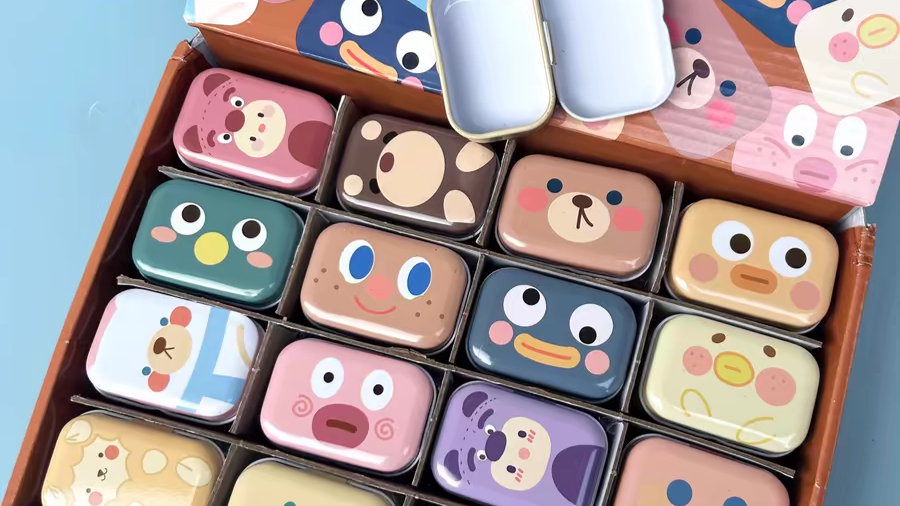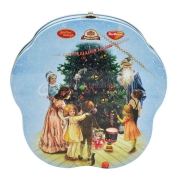How to do a multi-compartment design on custom tins?
Designing for multiple compartments in custom tins is about understanding the needs of the end product and how consumers interact with the packaging. To effectively create a multi-compartment custom tin, we consider factors such as product size, portion control, accessibility, structural integrity, and manufacturing feasibility to prevent flavor or color transfer between contents. First, we determine the number and size of compartments based on the customer’s product volume and the required number of compartments. Next, we evaluate material thickness and tinplate grade (e.g., 0.23mm D+E tinplate) to ensure that the inner walls can withstand handling without deformation. Finally, consider the complexity of the mold. Also considered is the lid seal (gasket or snap-on structure), which must ensure that all compartments are sealed.
Material Selection and Structural Considerations
When implementing multi-compartment functionality in custom tin cans, the choice of tinplate and coating is critical. We select high-strength tinplate, such as C+EF grade, to ensure that the inner walls can maintain their shape even when subjected to pressure during stacking or transportation. Additionally, the use of epoxy phenolic lining can prevent corrosion and protect sensitive products, such as chocolate or pharmaceuticals. We use 0.23 mm-thick tinplate and 7-micron-thick epoxy lining for food-grade compartments to ensure durability and compliance with FDA regulations.
Precision die-cutting machines score and fold internal walls with micron-level accuracy, creating flawless, sealed joints that eliminate gaps. At the same time, we don’t overlook exterior coating options, including matte, glossy, or soft-touch finishes, which can enhance shelf appeal while adding a layer of scratch protection. This structural integrity extends to the design of the lid, ensuring that the seam surrounds all compartments without bending and provides an even, leak-proof closure throughout the custom tin.
Divider Design and Integrated Technology for Custom Tins
The divider serves as the multi-compartment tin’s core component, controlling content separation and ensuring user accessibility. We choose between one-piece dividers or press-fit divider inserts. This way, you can optimize production speed or post-fill flexibility. And, we evaluate the geometry of the divider using CAD simulations to ensure that the insert tabs lock securely without stressing the can wall. One-piece dividers can reduce the number of parts, but require precise mold adjustments to prevent metal thinning at the fold line and may limit the internal surface finish.
In contrast, removable inserts allow for later customization or cleaning, but require tolerance control of ±0.1 mm to avoid shaking or misalignment. We will also consider material treatment, lubricating coatings, or micro-textured surfaces to facilitate the removal of inserts.
Printing, labeling, and the consumer experience of custom tins
Multi-compartment custom tins require not only functional dividers but also attractive graphics to guide users. In addition to full-coverage offset or digital printing, we can also use local UV or soft matte finishes on the compartment covers to highlight the individual sections, helping consumers identify flavors or uses at a glance. Additionally, the graphic design we can add includes mapping each compartment to a unique panel, ensuring that the brand information matches the compartment contents. Additionally, clear labels on the inner and outer walls can help guide access. For example, numbered compartments corresponding to “tasting order” enhance the consumer experience of gourmet tins. Our production team rigorously tests print registration and maintains multi-color alignment within 0.2 mm tolerances to guarantee consistent visual quality.
Manufacturing Process and Cost Considerations
Engineers must balance design complexity with production capabilities to manufacture multi-compartment custom tins cost-effectively. For example, each additional partition increases the number of mold stations, which increases the unit cost per wall by 5-7%. Additionally, complex lid designs may necessitate the use of a double-seam welder instead of a single-seam welder, resulting in increased capital expenditures. Our mold engineers minimize mold complexity by combining operations such as coining and bending into a single station. In addition, optimizing the blank nesting layout can reduce material scrap by up to 12%. By comparing costs with assembly speed, material yield, and market price points, you can select a custom can configuration that provides high quality without sacrificing profit margins, ensuring profitability.
Quality Control and Regulatory Compliance
Quality control is crucial for multi-compartment custom tins, as even a single misaligned partition can compromise the entire package. First, the fold of the partitions is dimensionally checked to ensure that the height and wall thickness remain within a tolerance of ±0.05 mm. Then, leak and pressure tests are performed at an internal pressure of 2 bar to simulate transportation conditions. Additionally, for food and pharmaceutical applications, we ensure compliance with FDA and EU directives for food contact materials. In the pharmaceutical industry, tamper-proof features and serialization may also be mandatory, placing higher standards on label durability and print clarity. Our rigorous quality control process guarantees that every batch of custom canned products meets all structural and regulatory standards, protecting both brand reputation and consumer safety.
Strategy for multi-compartment design
Creating multi-compartment custom cans requires a comprehensive approach, and we balance material selection, partition integration, aesthetic finish, manufacturing feasibility, cost control, and strict quality assurance. Tinplate, mold design, and printing processes are adjusted according to product application, and then molds and quality control procedures are optimized to provide strong and durable, custom tin packaging.





-180x180.jpg)






 Facebook
Facebook Twitter
Twitter Linkedin
Linkedin
